First Implementation of a Normalized Hotspot Index on Himawari-8 and GOES-R Data for the Active Volcanoes Monitoring: Results and Future Developments
Abstract
:1. Introduction
2. Data
3. Methods
3.1. NHI Indices
3.2. NHI Implementation on Himawari-8 AHI and GOES-R ABI Data
4. Results
4.1. Ambrym (Indonesia) 14–15 December 2018 Eruption
4.2. Krakatau (Indonesia) September 2018 Eruption
4.3. Kilauea (HI, USA) December 2020–May 2021 Eruption
5. Discussion
6. Conclusions
Author Contributions
Funding
Data Availability Statement
Acknowledgments
Conflicts of Interest
References
- Prins, E.M.; Feltz, J.M.; Menzel, W.P.; Ward, D.E. An overview of GOES-8 diurnal fire and smoke results for SCAR-B and 1995 fire season in South America. J. Geophys. Res. Atmos. 1998, 103, 31821–31835. [Google Scholar] [CrossRef]
- Roberts, G.; Wooster, M.J.; Perry, G.L.; Drake, N.; Rebelo, L.M.; Dipotso, F. Retrieval of biomass combustion rates and totals from fire radiative power observations: Application to southern Africa using geostationary SEVIRI imagery. J. Geophys. Res. Atmos. 2005, 110, D24311. [Google Scholar] [CrossRef] [Green Version]
- Calle, A.; González-Alonso, F.; de Miguel, S.M. Validation of active forest fires detected by MSG-SEVIRI by means of MODIS hot spots and AWiFS images. Int. J. Remote Sens. 2008, 29, 3407–3415. [Google Scholar] [CrossRef]
- Amraoui, M.; DaCamara, C.C.; Pereira, J.M.C. Detection and monitoring of African vegetation fires using MSG-SEVIRI imagery. Remote Sens. Environ. 2010, 114, 1038–1052. [Google Scholar] [CrossRef]
- Filizzola, C.; Corrado, R.; Marchese, F.; Mazzeo, G.; Paciello, R.; Pergola, N.; Tramutoli, V. RST-FIRES, an exportable algorithm for early-fire detection and monitoring: Description, implementation, and field validation in the case of the MSG-SEVIRI sensor. Remote Sens. Environ. 2016, 186, 196–216. [Google Scholar] [CrossRef]
- Wooster, M.J.; Roberts, G.J.; Giglio, L.; Roy, D.P.; Freeborn, P.H.; Boschetti, L.; Justice, C.; Ichoku, C.; Schroeder, W.; Davies, D.; et al. Satellite remote sensing of active fires: History and current status, applications and future requirements. Remote Sens. Environ. 2021, 267, 112694. [Google Scholar] [CrossRef]
- Harris, A.J.L.; Pilger, E.; Flynn, L.P.; Garbeil, H.; Mouginis-Mark, P.J.; Kauahikaua, J.; Thornber, C. Automated, high temporal resolution, thermal analysis of Kilauea volcano, Hawai’i, using GOES satellite data. Int. J. Remote Sens. 2001, 22, 945–967. [Google Scholar] [CrossRef] [Green Version]
- Pergola, N.; Marchese, F.; Tramutoli, V.; Filizzola, C.; Ciampa, M. Advanced satellite technique for volcanic activity monitoring and early warning. Ann. Geophys. 2008, 51, 287–301. [Google Scholar] [CrossRef]
- Hirn, B.; Di Bartola, C.; Ferrucci, P. Combined use of SEVIRI and MODIS for detecting, measuring, and monitoring active lava flows at erupting volcanoes. IEEE Trans. Geosci. Remote Sens. 2009, 47, 2923–2930. [Google Scholar] [CrossRef]
- Marchese, F.; Filizzola, C.; Mazzeo, G.; Paciello, R.; Pergola, N.; Tramutoli, V. Robust satellite techniques for thermal volcanic activity monitoring, early warning and possible prediction of new eruptive events. In Proceedings of the 2009 IEEE International Geoscience and Remote Sensing Symposium, Cape Town, South Africa, 12–17 July 2009; Volume 2, pp. I-953–II-956. [Google Scholar]
- Ganci, G.; Harris, A.J.L.; Del Negro, C.; Guehenneux, Y.; Cappello, A.; Labazuy, P.; Calvari, S.; Gouhier, M. A year of lava fountaining at Etna: Volumes from SEVIRI. Geophys. Res. Lett. 2012, 39, L06305. [Google Scholar] [CrossRef]
- Gouhier, M.; Harris, A.; Calvari, S.; Labazuy, P.; Guéhenneux, F.; Donnadieu, F.; Valade, S. Lava discharge during Etna’s January 2011 fire fountain tracked using MSG-SEVIRI. Bull. Volcanol. 2012, 74, 787–793. [Google Scholar] [CrossRef]
- Marchese, F.; Filizzola, C.; Lacava, T.; Falconieri, A.; Faruolo, M.; Genzano, N.; Mazzeo, G.; Pietrapertosa, C.; Pergola, N.; Tramutoli, V.; et al. Etna paroxysms of February–April 2021 monitored and quantified through a multi-platform satellite observing system. Remote Sens. 2021, 13, 3074. [Google Scholar] [CrossRef]
- Marchese, F.; Malvasi, G.; Ciampa, M.; Filizzola, C.; Pergola, N.; Tramutoli, V. A robust multitemporal satellite technique for volcanic activity monitoring: Possible impacts on volcanic hazard mitigation. In Proceedings of the 2007 International Workshop on the Analysis of Multi-temporal Remote Sensing Images, Leuven, Belgium, 18–20 July 2007. [Google Scholar]
- Girina, O.A. On precursor of Kamchatkan volcanoes eruptions based on data from satellite monitoring. J. Volcanol. Seismol. 2012, 6, 142–149. [Google Scholar] [CrossRef] [Green Version]
- Marchese, F.; Falconieri, A.; Pergola, N.; Tramutoli, V. A retrospective analysis of the Shinmoedake (Japan) eruption of 26–27 January 2011 by means of Japanese geostationary satellite data. J. Volcanol. Geotherm. Res. 2014, 269, 1–13. [Google Scholar] [CrossRef]
- Bessho, K.; Date, K.; Hayashi, M.; Ikeda, A.; Imai, T.; Inoue, H.; Kumagai, Y.; Miyakawa, T.; Murata, H.; Ohno, T.; et al. An introduction to Himawari-8/9—Japan’s new-generation geostationary meteorological satellites. J. Meteorol. Soc. Japan. Ser. II 2016, 94, 151–183. [Google Scholar] [CrossRef] [Green Version]
- Pavolonis, M.J.; Sieglaff, J.M.; Cintineo, J.L. Remote sensing of volcanic ash with the GOES-R series. In The GOES-R Series; Elsevier: Amsterdam, The Netherlands, 2020; pp. 103–124. [Google Scholar]
- Kaneko, T.; Takasaki, K.; Maeno, F.; Wooster, M.J.; Yasuda, A. Himawari-8 infrared observations of the June–August 2015 Mt Raung eruption, Indonesia. Earth Planets Space 2018, 70, 89. [Google Scholar] [CrossRef] [Green Version]
- Kaneko, T.; Yasuda, A.; Yoshizaki, Y.; Takasaki, K.; Honda, Y. Pseudo-thermal anomalies in the shortwave infrared bands of the Himawari-8 AHI and their correction for volcano thermal observation. Earth Planets Space 2018, 70, 175. [Google Scholar] [CrossRef]
- Kaneko, T.; Yasuda, A.; Fujii, T. Simple empirical method for estimating lava-effusion rate using night-time Himawari-8 1.6-µm infrared images. Earth Planets Space 2021, 73, 37. [Google Scholar] [CrossRef]
- Shreve, T.; Grandin, R.; Boichu, M. Reservoir depressurization driven by passive gas emissions at Ambrym volcano. Earth Planet. Sci. Lett. 2022, 584, 117512. [Google Scholar] [CrossRef]
- Schmit, T.J.; Gunshor, M.M. ABI Imagery from the GOES-R Series. In The GOES-R Series; Elsevier: Amsterdam, The Netherlands, 2020; pp. 23–34. [Google Scholar]
- Thompson, J.O.; Contreras-Arratia, R.; Befus, K.S.; Ramsey, M.S. Thermal and seismic precursors to the explosive eruption at La Soufrière Volcano, St. Vincent in April 2021. Earth Planet. Sci. Lett. 2022, 592, 117621. [Google Scholar] [CrossRef]
- Marchese, F.; Genzano, N.; Neri, M.; Falconieri, A.; Mazzeo, G.; Pergola, N. A Multi-Channel Algorithm for Mapping Volcanic Thermal Anomalies by Means of Sentinel-2 MSI and Landsat-8 OLI Data. Remote Sens. 2019, 11, 2876. [Google Scholar] [CrossRef] [Green Version]
- Genzano, N.; Pergola, N.; Marchese, F. A Google Earth Engine tool to investigate, map and monitor volcanic thermal anomalies at global scale by means of mid-high spatial resolution satellite data. Remote Sens. 2020, 12, 3232. [Google Scholar] [CrossRef]
- Gorelick, N.; Hancher, M.; Dixon, M.; Ilyushchenko, S.; Thau, D.; Moore, R. Google Earth Engine: Planetary-scale geospatial analysis for everyone. Remote Sens. Environ. 2017, 202, 18–27. [Google Scholar] [CrossRef]
- Geostationary Operational Environmental Satellites—R Series. A collaborative NASA and NOAA Program. Mission Overview. Available online: https://www.goes-r.gov/ (accessed on 6 September 2022).
- Hall, J.V.; Zhang, R.; Schroeder, W.; Huang, C.; Giglio, L. Validation of GOES-16 ABI and MSG SEVIRI active fire products. Int. J. Appl. Earth Obs. Geoinf. 2019, 83, 101928. [Google Scholar] [CrossRef]
- Zhao, Y.; Ban, Y. GOES-R Time Series for Early Detection of Wildfires with Deep GRU-Network. Remote Sens. 2022, 14, 4347. [Google Scholar] [CrossRef]
- Li, F.; Zhang, X.; Kondragunta, S.; Schmidt, C.C.; Holmes, C.D. A preliminary evaluation of GOES-16 active fire product using Landsat-8 and VIIRS active fire data, and ground-based prescribed fire records. Remote Sens. Environ. 2020, 237, 111600. [Google Scholar] [CrossRef]
- Smart, D. The first hour of the paroxysmal phase of the 2022 Hunga Tonga–Hunga Ha’apai volcanic eruption as seen by a geostationary meteorological satellite. Weather 2022, 77, 81–82. [Google Scholar] [CrossRef]
- Ishii, K.; Hayashi, Y.; Shimbori, T. Using Himawari-8, estimation of SO2 cloud altitude at Aso volcano eruption, on 8 October 2016. Earth Planets Space 2018, 70, 19. [Google Scholar] [CrossRef] [Green Version]
- Marchese, F.; Falconieri, A.; Pergola, N.; Tramutoli, V. Monitoring the Agung (Indonesia) ash plume of November 2017 by means of infrared Himawari 8 data. Remote Sens. 2018, 10, 919. [Google Scholar] [CrossRef] [Green Version]
- Mazzeo, G.; Ramsey, M.S.; Marchese, F.; Genzano, N.; Pergola, N. Implementation of the NHI (normalized hot spot indices) algorithm on infrared ASTER data: Results and future perspectives. Sensors 2021, 21, 1538. [Google Scholar] [CrossRef]
- Fisher, D.; Wooster, M.J. Multi-decade global gas flaring change inventoried using the ATSR-1, ATSR-2, AATSR and SLSTR data records. Remote Sens. Environ. 2019, 232, 111298. [Google Scholar] [CrossRef]
- Faruolo, M.; Falconieri, A.; Genzano, N.; Lacava, T.; Marchese, F.; Pergola, N. A Daytime Multisensor Satellite System for Global Gas Flaring Monitoring. IEEE Trans. Geosci. Remote Sens. 2022, 60, 5001717. [Google Scholar] [CrossRef]
- Marchese, F.; Genzano, N.; Nolde, M.; Falconieri, A.; Pergola, N.; Plank, S. Mapping and characterizing the Kīlauea (Hawai’i) lava lake through Sentinel-2 MSI and Landsat-8 OLI observations of December 2020–February 2021. Environ. Model. Softw. 2022, 148, 105273. [Google Scholar] [CrossRef]
- Japan Meteorological Agency. Himawari-8/9: Himawari Standard Data—User’s Guide; Version 1.2; Japan Meteorological Agency: Tokyo, Japan, 2015; p. 22. Available online: https://www.data.jma.go.jp/mscweb/en/himawari89/space_segment/hsd_sample/HS_D_users_guide_en_v12.pdf (accessed on 6 September 2022).
- Schmit, T.J.; Griffith, P.; Gunshor, M.M.; Daniels, J.M.; Goodman, S.J.; Lebair, W.J. A closer look at the ABI on the GOES-R series. Bull. Am. Meteorol. Soc. 2017, 98, 681–698. [Google Scholar] [CrossRef]
- GOES-R Series Product Definition and Users’ Guide. Available online: https://www.goes-r.gov/products/docs/PUG-Appendix-X.pdf (accessed on 6 September 2022).
- GOES-16 MCMIPF Series ABI Level 2 Cloud and Moisture Imagery Full Disk. Available online: https://developers.google.com/earth-engine/datasets/catalog/NOAA_GOES_16_MCMIPF (accessed on 6 September 2022).
- GOES-R Advanced Baseline Imager (ABI) Algorithm Theoretical Basis Document for Cloud and Moisture Imagery Product (CMIP). Available online: https://www.star.nesdis.noaa.gov/goesr/documents/ATBDs/Baseline/ATBD_GOES-R_ABI_CMI_KPP_v3.0_July2012.pdf (accessed on 6 September 2022).
- Government of Vanatu, Vanuatu Volcano Alert Bulletin n°1—Ambrym Activity (25 January 2022). Available online: https://reliefweb.int/report/vanuatu/vanuatu-volcano-alert-bulletin-n-1-ambrym-activity-january-25th-2022 (accessed on 4 July 2022).
- Global Volcanism Program. Report on Ambrym (Vanuatu). Bulletin of the Global Volcanism Network; Bennis, K.L., Venzke, E., Eds.; Smithsonian Institution: Washington, DC, USA, 2020; Volume 45. [Google Scholar] [CrossRef]
- Moussallam, Y.; Médard, E.; Georgeais, G.; Rose-Koga, E.F.; Koga, K.T.; Pelletier, B.; Bani, P.; Shreve, T.L.; Grandin, R.; Boichu, M.; et al. How to turn off a lava lake? A petrological investigation of the 2018 intra-caldera and submarine eruptions of Ambrym volcano. Bull. Volcanol. 2021, 83, 36. [Google Scholar] [CrossRef]
- Shreve, T.; Grandin, R.; Boichu, M.; Garaebiti, E.; Moussallam, Y.; Ballu, V.; Delgado, F.; Leclerc, F.; Vallée, M.; Henriot, N.; et al. From prodigious volcanic degassing to caldera subsidence and quiescence at Ambrym (Vanuatu): The influence of regional tectonics. Sci. Rep. 2021, 9, 18868. [Google Scholar] [CrossRef] [Green Version]
- Marchese, F.; Coppola, D.; Falconieri, A.; Genzano, N.; Pergola, N. Investigating Phases of Thermal Unrest at Ambrym (Vanuatu) Volcano through the Normalized Hot Spot Indices Tool and the Integration with the MIROVA System. Remote Sens. 2022, 14, 3136. [Google Scholar] [CrossRef]
- Grilli, S.T.; Tappin, D.R.; Carey, S.; Watt, S.F.L.; Ward, S.N.; Grilli, A.R.; Engwell, S.L.; Zhang, C.; Kirby, J.T.; Schambach, L.; et al. Modelling of the tsunami from the 22 December 2018 lateral collapse of Anak Krakatau volcano in the Sunda Straits, Indonesia. Sci. Rep. 2019, 9, 11946. [Google Scholar] [CrossRef] [Green Version]
- Global Volcanism Program. Report on Krakatau (Indonesia). Bulletin of the Global Volcanism Network; Crafford, A.E., Venzke, E., Eds.; Smithsonian Institution: Washington, DC, USA, 2018; Volume 43. [Google Scholar] [CrossRef]
- Rösch, M.; and Plank, S. Detailed Mapping of Lava and Ash Deposits at Indonesian Volcanoes by Means of VHR PlanetScope Change Detection. Remote Sens. 2022, 14, 1168. [Google Scholar] [CrossRef]
- Wright, R.; Flynn, L.; Garbeil, H.; Harris, A.; Pilger, E. Automated volcanic eruption detection using MODIS. Remote Sens. Environ. 2002, 82, 135–155. [Google Scholar] [CrossRef] [Green Version]
- Fildes, R.A.; Turcotte, D.L.; Rundle, J.B. Natural Time Analysis and Nowcasting of Quasi-Periodic Collapse Events During the 2018 Kīlauea Volcano Eruptive Sequence. Earth Space Sci. 2022, 9, e2022EA002266. [Google Scholar] [CrossRef]
- Plank, S.; Massimetti, F.; Soldati, A.; Hess, K.U.; Nolde, M.; Martinis, S.; Dingwell, D.B. Estimates of lava discharge rate of 2018 Kīlauea Volcano, Hawai’i eruption using multi-sensor satellite and laboratory measurements. Int. J. Remote Sens. 2021, 42, 1492–1511. [Google Scholar] [CrossRef]
- Global Volcanism Program. Report on Kilauea (United States) Bulletin of the Global Volcanism Network; Bennis, K.L., Venzke, E., Eds.; Smithsonian Institution: Washington, DC, USA, 2021; Volume 46. [Google Scholar] [CrossRef]
- United Geological Survey. 2022; Recent Eruption. Available online: https://www.usgs.gov/volcanoes/kilauea/recent-eruption (accessed on 6 September 2022).
- Dennison, P.E.; Charoensiri, K.; Roberts, D.A.; Peterson, S.H.; Green, R.O. Wildfire temperature and land cover modeling using hyperspectral data. Remote Sens. Environ. 2006, 100, 212–222. [Google Scholar] [CrossRef]
- Coppola, D.; Laiolo, M.; Cigolini, C.; Donne, D.D.; Ripepe, M. Enhanced volcanic hot-spot detection using MODIS IR data: Results from the MIROVA system. Geol. Soc. Lond. Spec. Publ. 2016, 426, 181–205. [Google Scholar] [CrossRef]
- Radebaugh, J.; Lopes, R.M.; Howell, R.R.; Lorenz, R.D.; Turtle, E.P. Eruptive behavior of the Marum/Mbwelesu lava lake, Vanuatu and comparisons with lava lakes on Earth and Io. J. Volcanol. Geotherm. Res. 2016, 322, 105–118. [Google Scholar] [CrossRef]
- Marchese, F.; and Genzano, N. Global volcano monitoring through the NHI (Normalized Hot Spot Indices) system. J. Geol. Soc. 2022, jgs2022-014. [Google Scholar] [CrossRef]
- Zhang, Q.; Ge, L.; Zhang, R.; Metternicht, G.I.; Liu, C.; Du, Z. Towards a Deep-Learning-Based Framework of Sentinel-2 Imagery for Automated Active Fire Detection. Remote Sens. 2021, 13, 4790. [Google Scholar] [CrossRef]
- Tramutoli, V. Robust satellite techniques (RST) for natural and environmental hazards monitoring and mitigation: Theory and applications. In Proceedings of the 2007 International Workshop on the Analysis of Multi-Temporal Remote Sensing Images, Leuven, Belgium, 18–20 July 2007; pp. 1–6. [Google Scholar]
- Pergola, N.; Coviello, I.; Filizzola, C.; Lacava, T.; Marchese, F.; Paciello, R.; Tramutoli, V. A review of RSTVOLC, an original algorithm for automatic detection and near-real-time monitoring of volcanic hotspots from space. Geol. Soc. Lond. Spec. Publ. 2016, 426, 55–72. [Google Scholar] [CrossRef]
- Engel, C.B.; Jones, S.D.; Reinke, K.J. Fire Radiative Power (FRP) Values for Biogeographical Region and Individual Geostationary HHMMSS Threshold (BRIGHT) Hotspots Derived from the Advanced Himawari Imager (AHI). Remote Sens. 2022, 14, 2540. [Google Scholar] [CrossRef]
- Koeppen, W.C.; Pilger, E.; Wright, R. Time series analysis of infrared satellite data for detecting thermal anomalies: A hybrid approach. Bull. Volcanol. 2011, 73, 577–593. [Google Scholar] [CrossRef]
- Eumetsat. Flexible Combined Imager (FCI). Available online: https://www.eumetsat.int/mtg-flexible-combined-imager-fci (accessed on 21 July 2022).
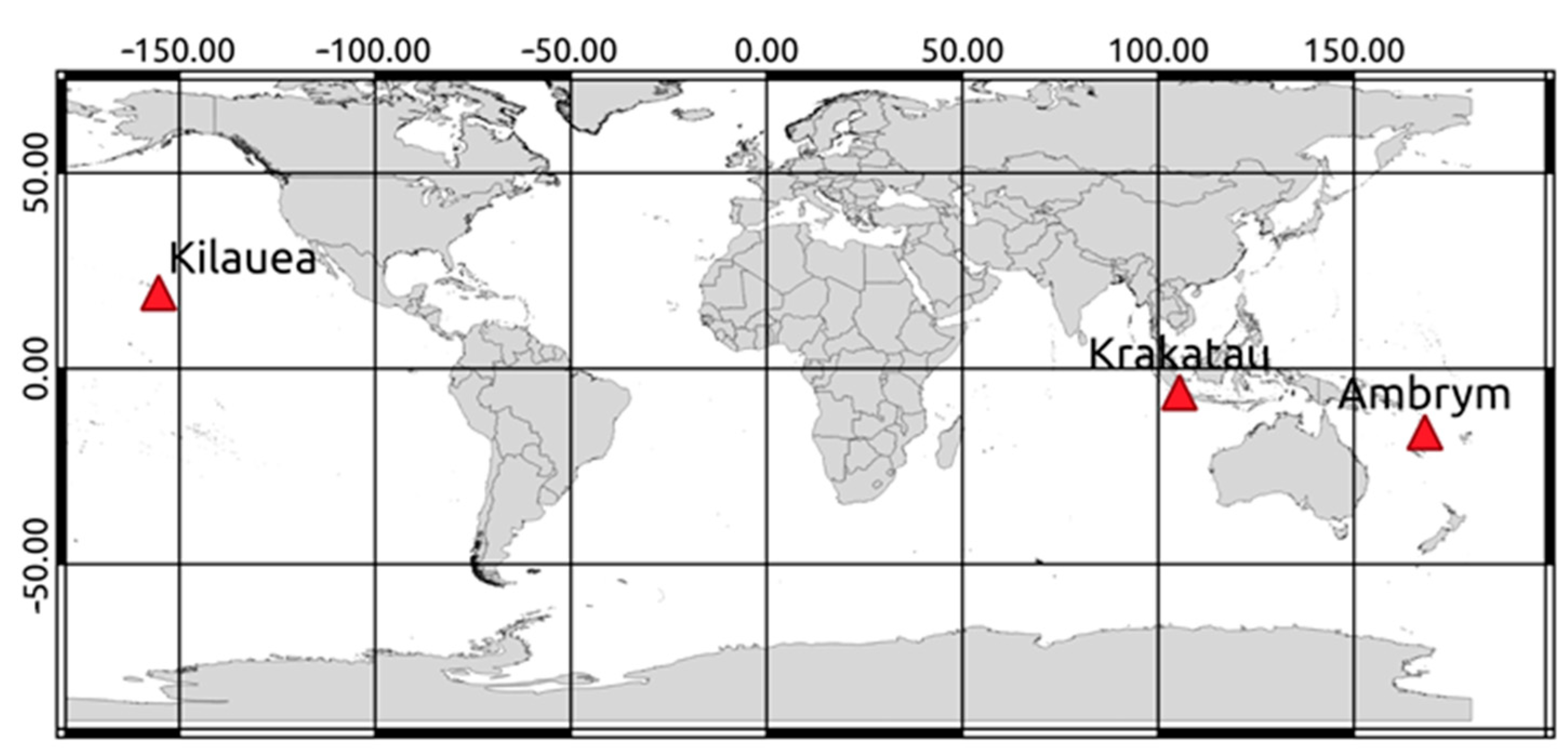

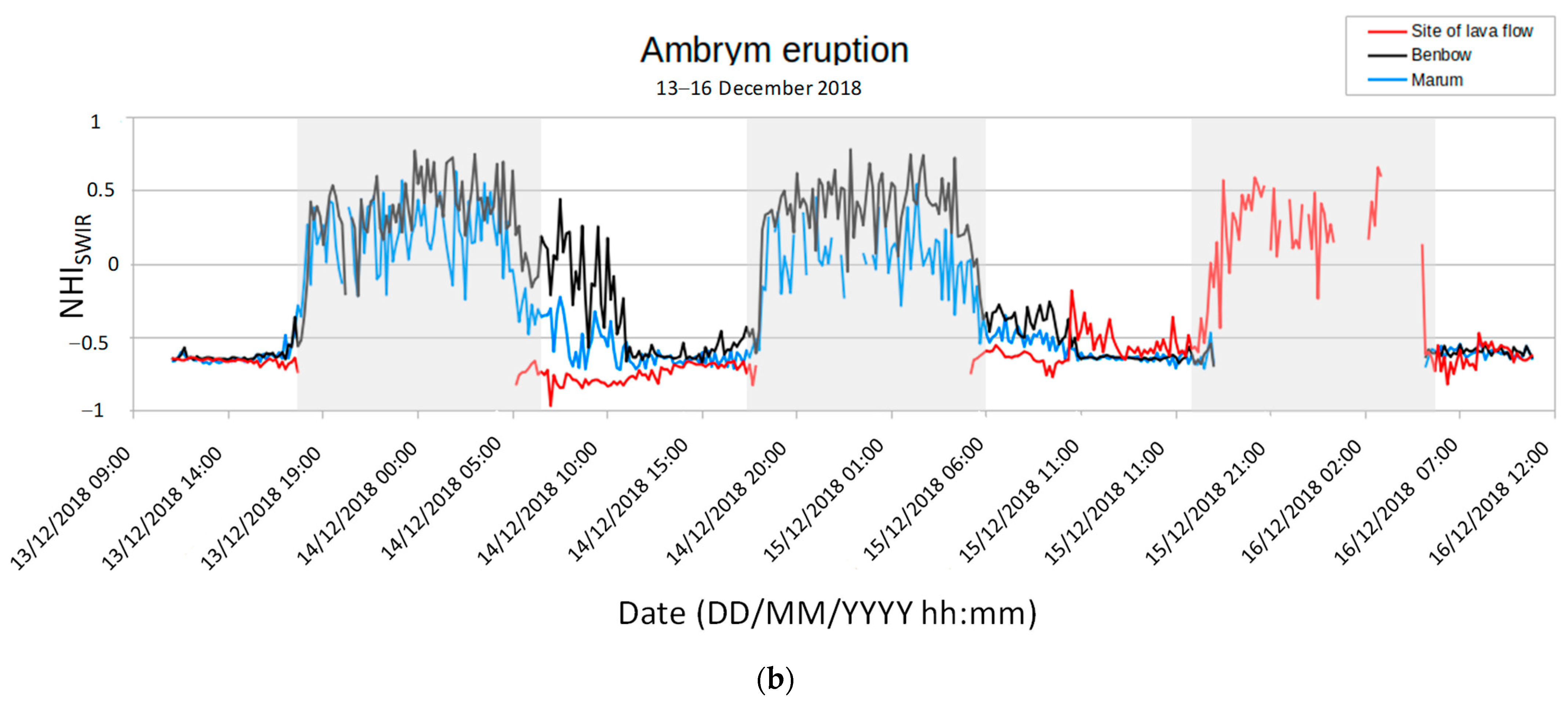
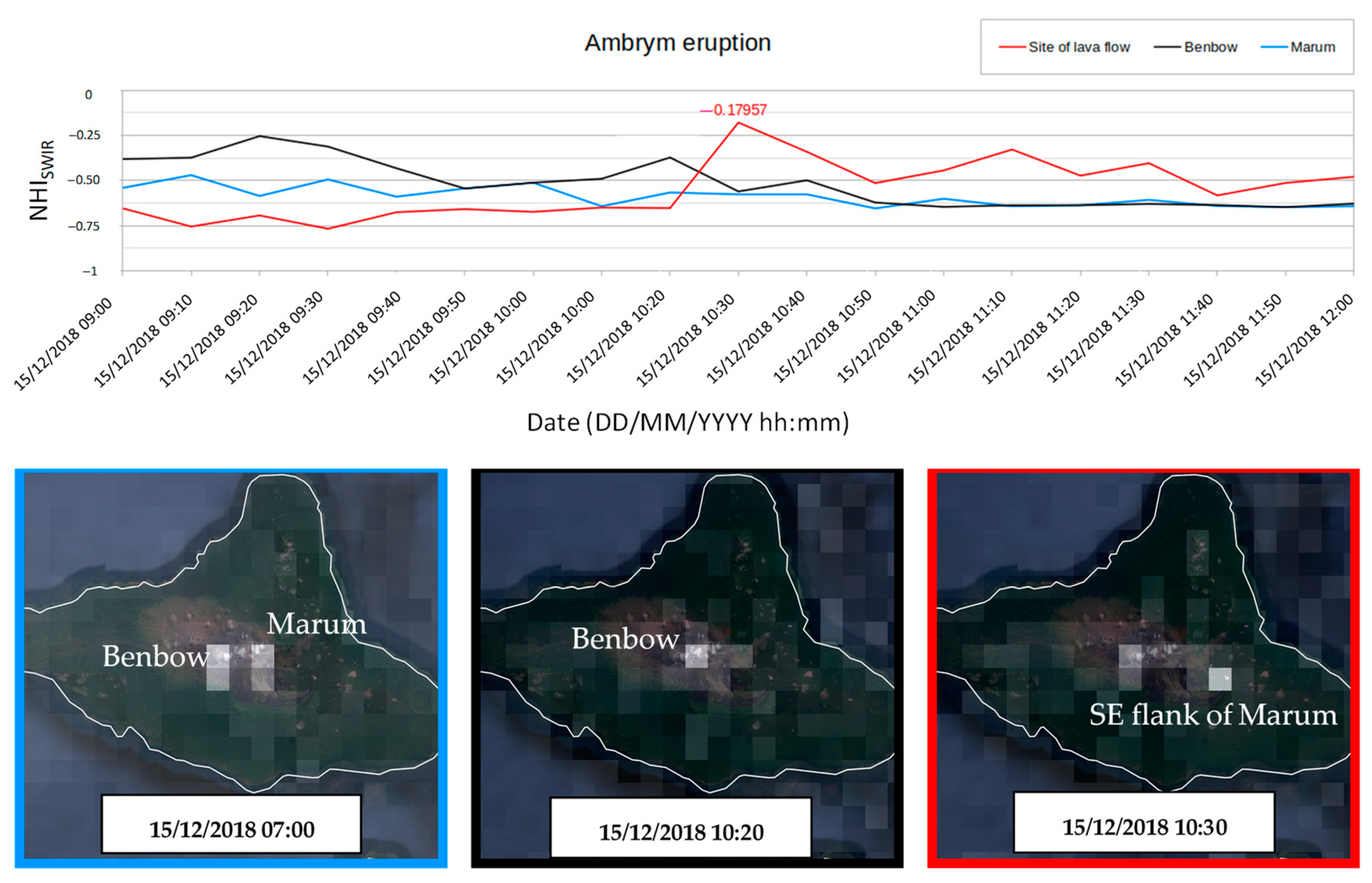
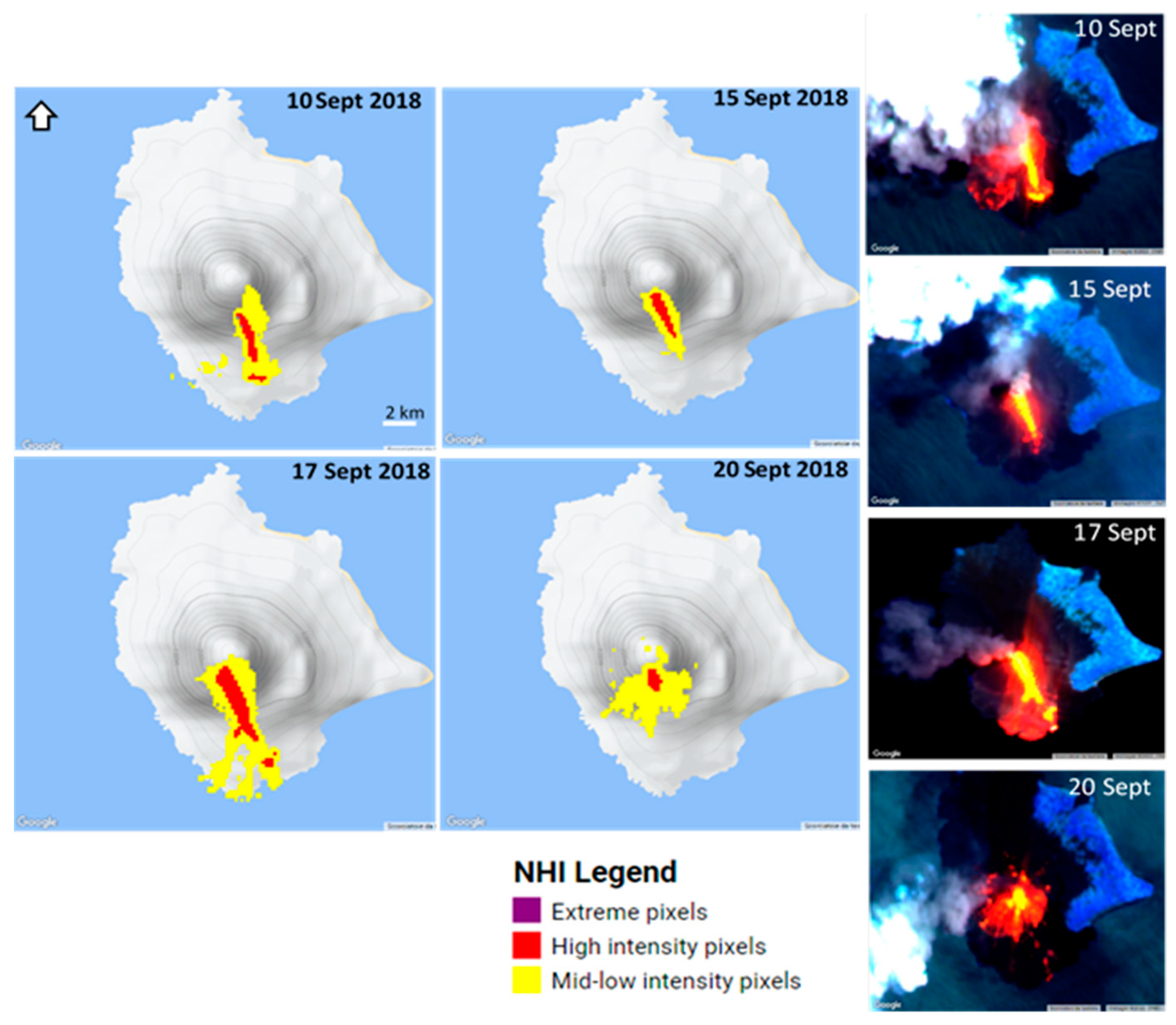
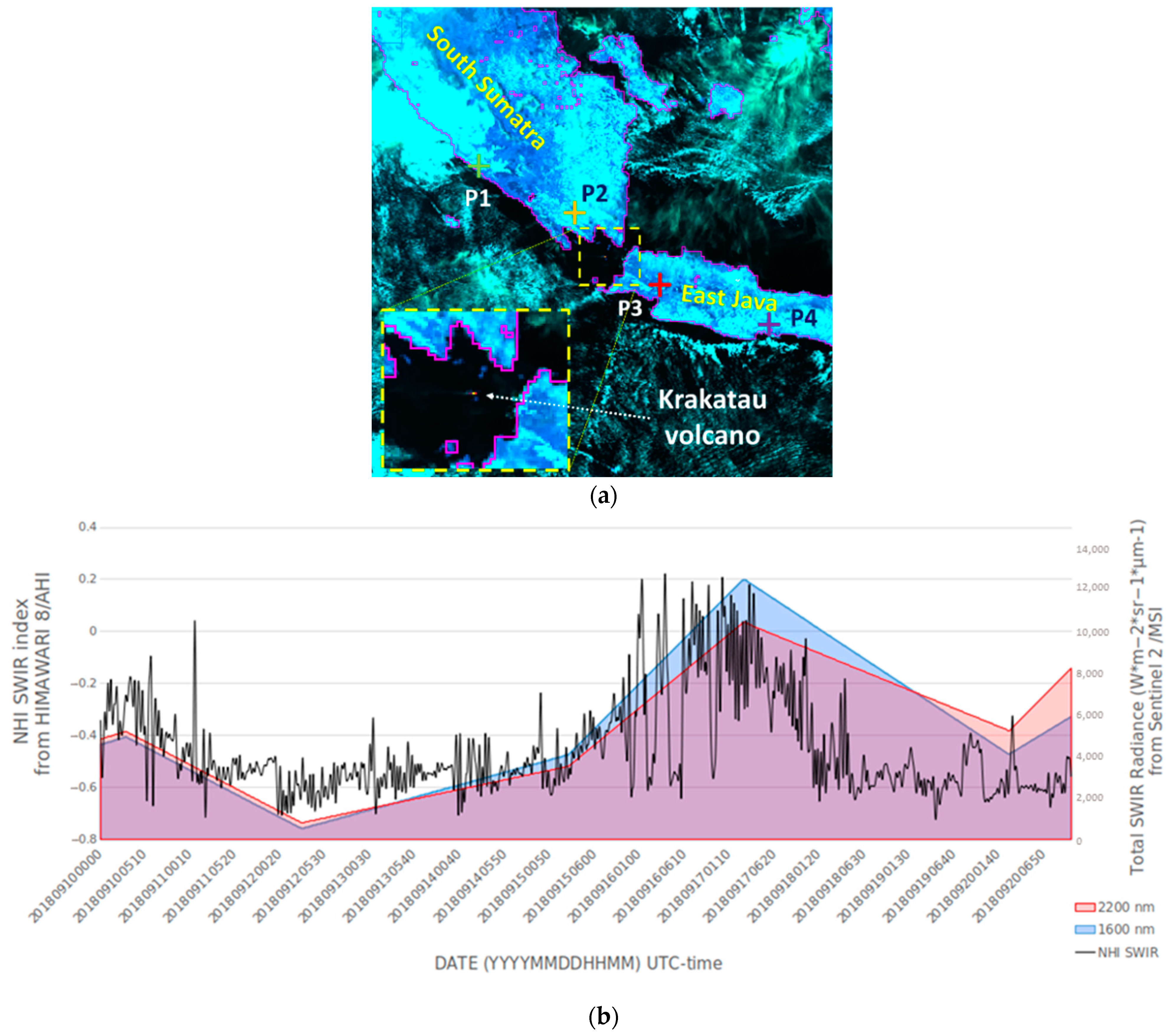

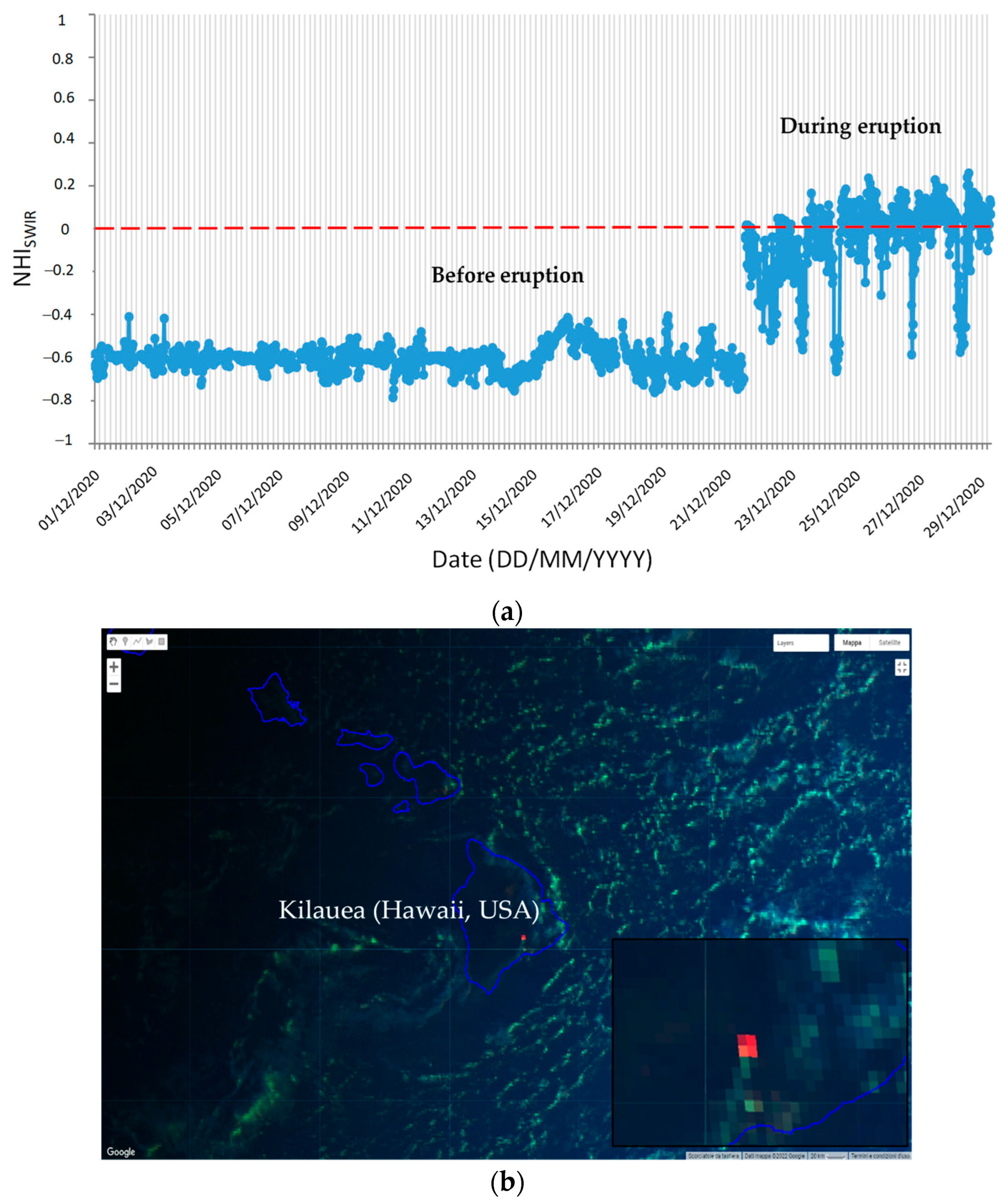
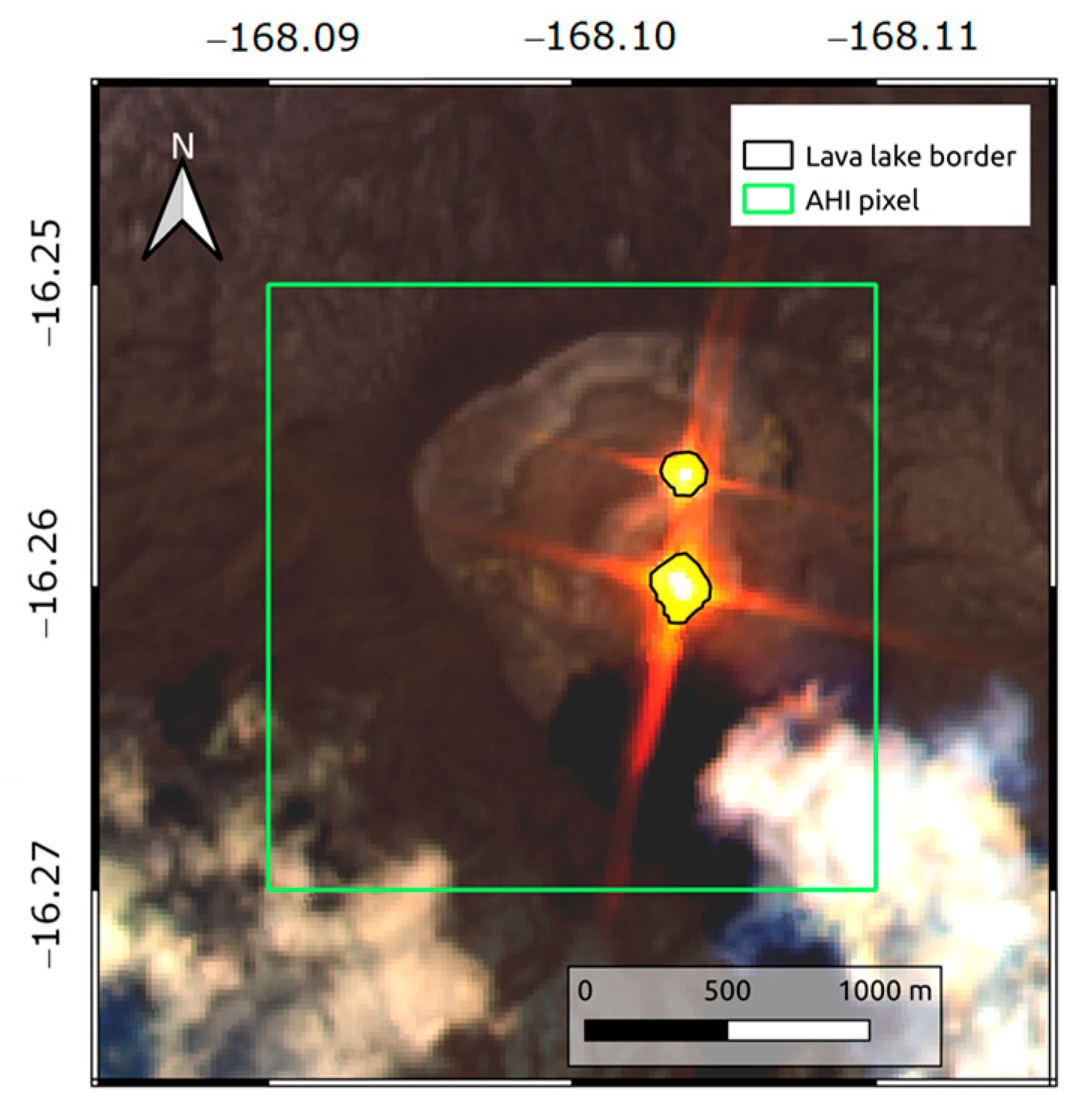
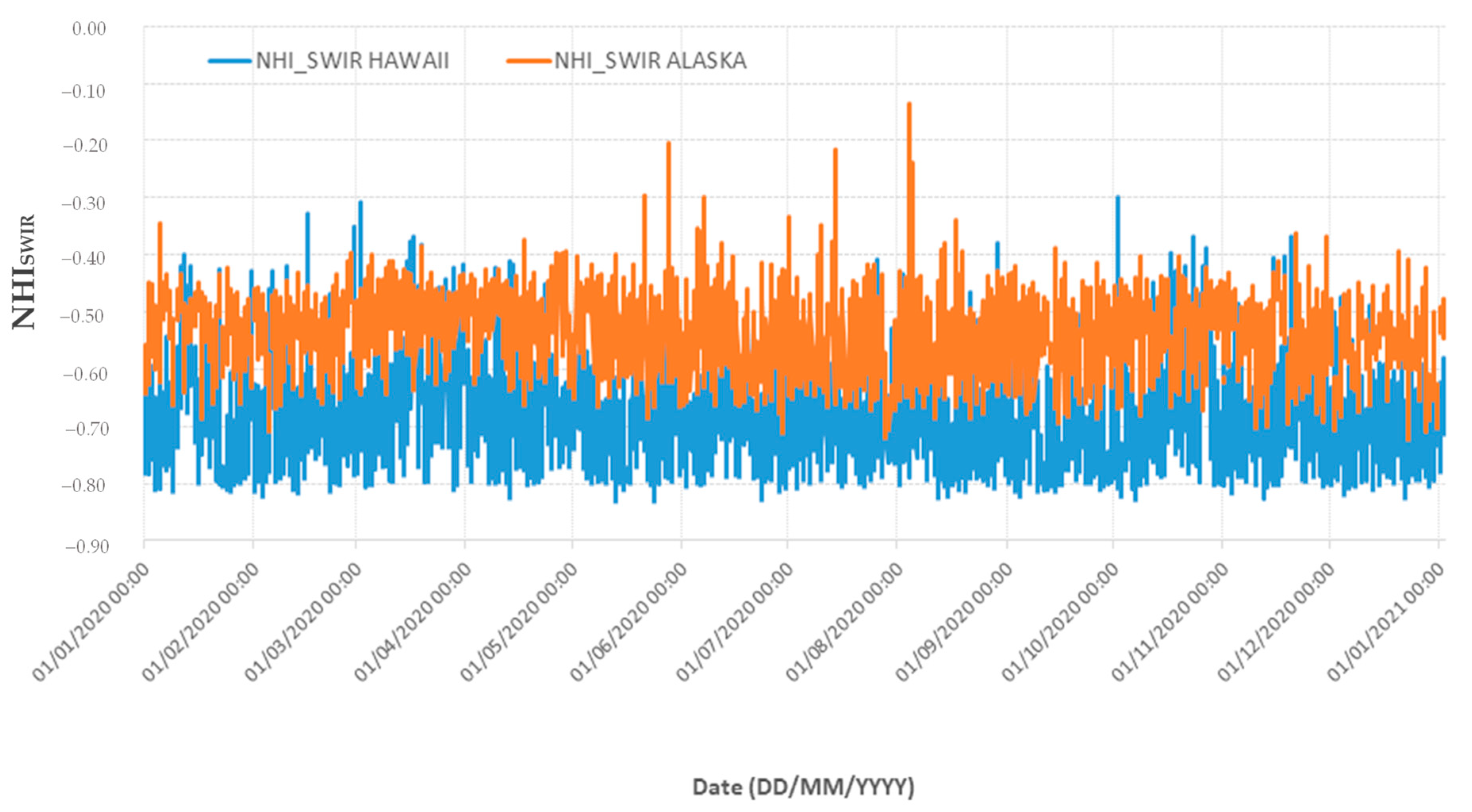
| Spectral Bands | Central Wavelength (µm) | Spatial Resolution at the SSP (km) |
|---|---|---|
| 1 | 0.47 | 1 |
| 2 | 0.51 | 1 |
| 3 | 0.64 | 0.5 |
| 4 | 0.86 | 1 |
| 5 | 1.6 | 2 |
| 6 | 2.3 | 2 |
| 7 | 3.9 | 2 |
| 8 | 6.2 | 2 |
| 9 | 6.9 | 2 |
| 10 | 7.3 | 2 |
| 11 | 8.6 | 2 |
| 12 | 9.6 | 2 |
| 13 | 10.4 | 2 |
| 14 | 11.2 | 2 |
| 15 | 12.4 | 2 |
| 16 | 13.3 | 2 |
| Spectral Bands | Central Wavelength (µm) | Spatial Resolution at the SSP (km) |
|---|---|---|
| 1 | 0.47 | 1 |
| 2 | 0.64 | 0.5 |
| 3 | 0.86 | 1 |
| 4 | 1.37 | 2 |
| 5 | 1.6 | 1 |
| 6 | 2.2 | 2 |
| 7 | 3.9 | 2 |
| 8 | 6.2 | 2 |
| 9 | 6.9 | 2 |
| 10 | 7.3 | 2 |
| 11 | 8.4 | 2 |
| 12 | 9.6 | 2 |
| 13 | 10.3 | 2 |
| 14 | 11.2 | 2 |
| 15 | 12.3 | 2 |
| 16 | 13.3 | 2 |
Publisher’s Note: MDPI stays neutral with regard to jurisdictional claims in published maps and institutional affiliations. |
© 2022 by the authors. Licensee MDPI, Basel, Switzerland. This article is an open access article distributed under the terms and conditions of the Creative Commons Attribution (CC BY) license (https://creativecommons.org/licenses/by/4.0/).
Share and Cite
Falconieri, A.; Genzano, N.; Mazzeo, G.; Pergola, N.; Marchese, F. First Implementation of a Normalized Hotspot Index on Himawari-8 and GOES-R Data for the Active Volcanoes Monitoring: Results and Future Developments. Remote Sens. 2022, 14, 5481. https://doi.org/10.3390/rs14215481
Falconieri A, Genzano N, Mazzeo G, Pergola N, Marchese F. First Implementation of a Normalized Hotspot Index on Himawari-8 and GOES-R Data for the Active Volcanoes Monitoring: Results and Future Developments. Remote Sensing. 2022; 14(21):5481. https://doi.org/10.3390/rs14215481
Chicago/Turabian StyleFalconieri, Alfredo, Nicola Genzano, Giuseppe Mazzeo, Nicola Pergola, and Francesco Marchese. 2022. "First Implementation of a Normalized Hotspot Index on Himawari-8 and GOES-R Data for the Active Volcanoes Monitoring: Results and Future Developments" Remote Sensing 14, no. 21: 5481. https://doi.org/10.3390/rs14215481






